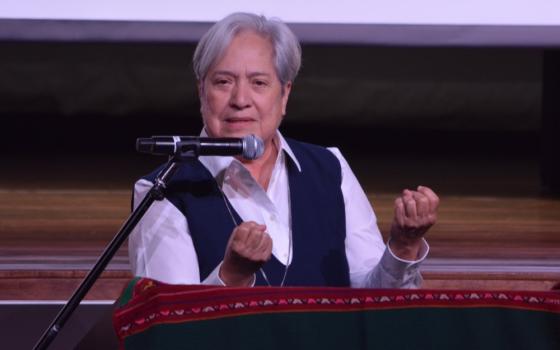
When Bishop Larry Silva returned in 2005 to Honolulu, his birthplace, he knew instinctively that he needed a map. But it wasn’t the physical geography of the 6,500-mile, 66-parish diocese serving the state’s six major islands that puzzled the church’s new leader. Rather, Silva needed a strategic plan to help guide the future of this statewide church, which is expected to grow by more than one-third over the next 20 years.
Silva turned to Fr. Marc Alexander, diocesan vicar general and theologian, and the late Tom Papandrew, director of planning. Between 2006 and 2008, they laid the groundwork, acting as itinerant listeners while hosting open meetings that included dozens of lay leaders at every parish. The process was demanding on everyone. Each parish created a fact sheet and had to list in writing its goals and concrete steps to implement them.
“The only restriction we placed on the open meetings was that each parish could only have three to six priorities,” said Alexander. “These evening meetings included a potluck supper and we stayed overnight in the rectories, both of which modeled collaboration.” Subsequent vicariate meetings were held that included the dozens of parish lay leaders from that region.
Disenfranchised Catholics were sought out for focus groups to listen to their concerns and to incorporate their views into the planning process.
This information was combined with demographic data, input from numerous diocesan bodies and other stakeholders. The strategic planning committee relied on outside professionals on an as-needed basis for certain aspects of the planning, including contributions from non-Catholic experts. Eventually, key findings emerged along with specific actions and performance indicators.
In 2008, a five-year strategic plan emerged, “Witness to Jesus: Diocesan Road Map for Pastoral, Program, and Facility Needs 2008-2013.” Six actions were emphasized: leadership development; youth and young adult programs; faith formation; homelessness; repair and maintenance of facilities; new parishes; and land management.
The road map received a special award from the Hawaii chapter of the American Planning Association.
“I am amazed at how much parishioners throughout the diocese are engaged in the implementation of the road map, not only at the diocesan level, but in their own parishes and vicariates,” said Silva. “I believe the key to this engagement is their initial participation in the formulation of the pastoral plan priorities that make up the road map.”
“No one was excluded,” explained Colleen O’Brien Sathre, a retired vice president of planning and policy at the University of Hawaii, who served on the strategic planning committee and is now chair of the 20-member Road Map Implementation Commission. “Today, the term road map has become embedded in the lexicon of the people,” she said.
Two years into the implementation phase of the road map, is it working?
The diocesan staff have been reorganized around the six goals and are empowered to work across departments where necessary to implement the goals.
Silva is insistent that the diocesan offices serve the people and the parishes, not the other way around. The implementation commission has adopted the popular Home Depot slogan, “You [the parishes] can do it. We [the diocesan offices] can help.”
“The road map brought us together in looking in one direction although varied in our responses in making the diocesan mission, ‘witness to Jesus,’ come alive and concretized,” said La Salette Fr. Efren Tomas, pastor of Christ the King Parish, Kahului, Maui. “The road map draws all of us in the diocese into the reality that we are interdependent,” said Tomas, who is also a former provincial of his order’s Philippines province.
Every parish budget and annual report are now oriented to the specific parish goals in the context of the road map. Meanwhile, the road map lists parcels of land the church owns with an emphasis on managing the assets. “Sixty-three of the 66 parishes have established active building and land committees,” said Alexander.
“The road map is a continuous spiritual journey that is strengthening the quality of parish and church communities by creating positive relationships among different groups and providing greater opportunities for participation in church life,” said Tom Pangilinan, a member of the Diocesan Pastoral Council and retired public school district superintendant.
And people are backing the road map with real dollars even during a difficult economic environment.
“Early on we made it known that funds were needed to make the road map a reality, and people stepped up to the plate, pledging over $57 million to a campaign goal of $30 million,” said Silva.
Silva remains prayerfully realistic about the remaining three years of the road map.
“There may be delays and detours, but we take them in stride because we have a sense that God is leading us along the way,” he said. “Sometimes just making the journey is to arrive at the destination to which the Lord Jesus calls us.”
[Tom Gallagher writes for NCR’s regular Mission Management column. His e-mail address is tom@tomgallagheronline.com.]
Online resources
Diocesan Road Map for the Future Roman Catholic Church in the State of Hawaii
www.catholichawaii.org/road_map/RoadMap.html
Top 7 keys to diocesan strategic planning
The following planning tips were gleaned from a long conversation with Fr. Marc Alexander and Colleen O’Brien Sathre:
- Get strong support from the bishop;
- Listen to the people and listen some more by building the plan from the bottom up;
- Use professional expertise as needed;
- Use a very open and transparent process and exclude no one;
- Limit the number of priorities to six;
- Keep the plan layout simple, and publish in an attractive format;
- Work the implementation immediately and in different ways.




